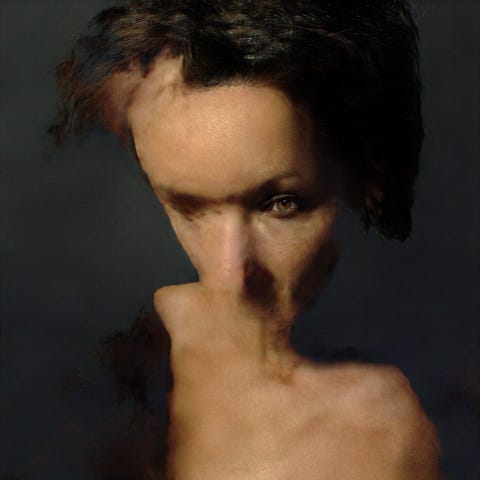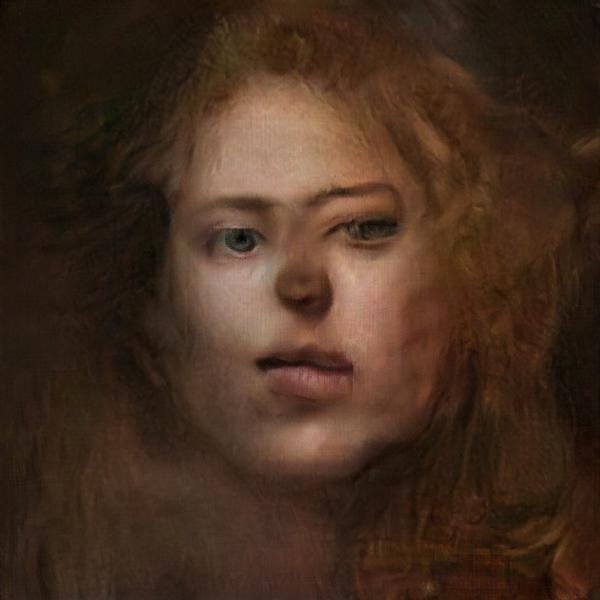"I consider code, the algorithm itself, a work of art." - Sergio Albiac
Sergio Albiac is an artist based in Barcelona, Spain, with a computer science and art background who works at the intersection of deep learning, generative computer code and traditional media. Interested in exploring the realm of possibilities that technology offers, and not limiting his artistic expression to a single medium or style, Albiac investigates how traditional and new media can blend together, bringing to life something of great value. Thus were born paintings, video art pieces, interactive installations running on the cloud, giclée prints and generative portraits [1].
Fascinated by the dialogues between control vs. randomness, and human vs. machine, the artist's work investigates also the concepts of identity, creativity, emotions, memories, and chance, and gives space to the tensions that arise when the reality we build in our heads confronts the external world.
[Fig. 1] What is real (2019), experimental artwork, Credit Sergio Albiac, image BY-NC-ND.
In The generative identity of Walter Vanhaerents, for example, a project and interactive art installation in partnership with Lexus, the artist transforms the car into a work of art. Each time the driver starts a journey, a new artwork is created using real time data from the car sensors. The output becomes a sum, and interpretation, of the artist's hand brushwork and generative aesthetics affected by the driving style and the duration of the drive. The project - which explores human identity by mixing choice and chance with randomness and control - has been a challenge and has pushed Albiac to further develop a flexible process of generative artistic creation that transforms meaning into artworks.
The artist investigates also the concept of creativity and artistic creation, comparing traditional and new media (and states of mind in the process). For instance, in Generative sketching, Albiac compares painting to a struggle between control and randomness, where the paint's behavior can not be fully mastered, but only affected by the technique chosen by the painter. The traditional sketching process, useful to test color and composition, starts with a vague idea that later takes on a clearer form as the work progresses. Once this idea is refined, it is put on a traditional medium giving life to a work of art. With neural sketching, instead, an idea in the artist's head is transformed into computer code, permitting to explore alternatives in a very different way compared to tradition. Writing the code for generating images to use as painting input, according to Albiac, could unleash the (infinite) potential of an artist.
[Fig.2] Artificially Grotesque 3 (2020), experimental artwork, Credit Sergio Albiac, image BY-NC-ND.
The idea of infinite artworks, not curated by the human artist, but truly novel and created by generative assistants, has occurred for the first time in Stardust. Here Albiac has hypothesized the use of technology to outsource the creation of art. Like he explains: "Modelling artistic decisions into software would provide a generative assistant that could even survive an artist in the creation of meaningful works of visual art."
Technically speaking, his first works started with the use of Processing and then with the incorporation of pure "code" through multiple programming languages up to the use of GANs. About that, Albiac says: “ I still use generative code and I am incorporating GANs and, in general, deep learning techniques into my practice. More than a shift, it is an expansion of my toolbox. I see more potential in an "integration" of generative code with deep learning and this is one of the strategies I am exploring, along with the more direct use of standalone GANs and dataset design and creation.”
When I asked him what he thought about Artificial Intelligence in the arts, he told me: “I am interested in AI as a disruptive technology in relation to the individual and society. And I am interested in AI as artistic metaphor for consciousness, will and instinct. Finally, I am interested in AI as an instrumental technology to model complex generative patterns of outputs that might be useful in my work.”
Our chat considered many other aspects. To read the full interview with Sergio Albiac, please visit my blog here.
Resources and References
[1] https://cuevagallery.com/blogs/explorations-of-ai-art/sergio-albiac
[2] https://www.sergioalbiac.com
Except where otherwise noted this work is licensed under a Creative Commons Attribution-ShareAlike 4.0 International License.




